GetStudySolution
Getstudysolution is an online educational platform that allows students to access quality educational services and study materials at no cost.
NCERT Solutions for class 4 Maths chapter 12 – How Heavy How Light
Back Exercise
Page No 134:
Question 1:
Father gave them some idea of the weight of each thing.
| Thing loaded | Weight |
| A sack of wheat | 100 kg |
| A sack of rice | 35 kg |
| Water tank | 50 kg |
| Almirah | 70 kg |
| A table | 10 kg |
| A chair | 5 kg |
| A mattress | 20 kg |
| Bamboo ladder | 10 kg |
| Pots and pans | 10 kg |
• Find out the total weight they had loaded on the cart. Now they decided to remove a few things from the cart. • Which things should be removed so that the weight of the load is not more than 700 kgs?
Answer:
- Weight of a water tank = 50 kg
Weight of 1 sack of wheat = 100 kg Weight of 5 sacks of wheat = 5 × 100 kg = 500 kg Weight of 1 table = 10 kg Weight of 3 tables = 3 × 10 kg = 30 kg Weight of an almirah = 70 kg Weight of 1 chair = 5 kg Weight of 4 chairs = 4 × 5 kg = 20 kg Weight of 1 mattress = 20 kg Weight of 2 mattresses = 2 × 20 kg = 40 kg Weight of 1 sack of rice = 35 kg Weight of 3 sacks of rice = 3 × 35 kg =105 kg Weight of a bamboo ladder =10 kg Weight of pots and pans = 10 kg Total weight loaded on the cart = 50 kg + 500 kg + 10 kg + 30 kg + 70 kg + 20 kg + 40 kg + 105 kg + 10 kg + 10 kg = 845 kg
- Weight of a water tank = 50 kg
Weight of an almirah = 70 kg Weight of 3 tables = 30 kg Total weight = 50 + 70 + 30 kg = 150 kg 3 tables, an almirah and a water tank are removed. ∴ Total weight loaded on the cart = 845 kg − 150 kg = 695 kg Working: 845-150695Thus, the tables, an almirah and a water tank should be removed so that weight of the load is not more than 700 kg.
Disclaimer: The answer may vary from student to student. The answer provided here is for reference only.
Question 2:
Now you also make your own balance. Write down how you made it. Also draw a picture of your balance in the box below.

Answer:
Disclaimer: The answer may vary from student to student based on his/her observation. It is highly recommended that students prepare the answer on their own.
Page No 135:
Question 1:
Activity Mannu and Jaiju put a pencil and a geometry box in the two pans of the balance. Which pan will go down? Why? Draw a picture to show it. 
Answer:
The pan with the geometry box will go down because the geometry box is heavier than the pencil.
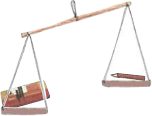
Question 2:
What is heavier? Make pairs of different things and use the balance to decide which is heavier. First guess which thing will take the pan down and then check with your balance.
Answer:
Disclaimer: The purpose of this section is to make the students observe their surroundings. The answer may vary from student to student based on his/her experience. It is highly recommended that the students prepare the answer on their own.
Question 3:
What is the heaviest? Make groups of three things. For example ― eraser, ball and paper. Use the balance to arrange them in order of weight – the lightest, the one with in–between weight, the heaviest. Complete the table with at least five example.
| Lightest | In-between weight | Heaviest |
| Paper | Eraser | Ball |
• Can you find your own weight using this balance?
Answer:
| Lightest | In-between weight | Heaviest |
| Paper | Eraser | Ball |
| Handkerchief | Scarf | Shawl |
| Grape | Date | Potato |
| Orange | Coconut | Pumpkin |
Groundnut | Lemon | Papaya |
We cannot find our weight using this balance.
Disclaimer: The answer may vary from student to student based on his/her experience. The answer provided here is for reference only.
Page No 137:
Question 1:
Practice Time • Which pan of the balance will go down? Show by drawing an arrow. 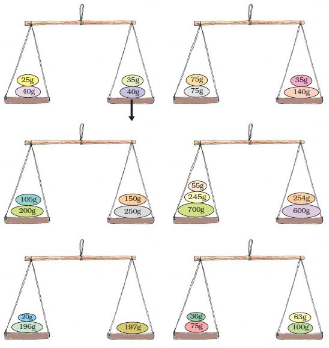
• Is the weight on any of the pans equal to 1 kilogram? Mark it. • How many grams are there in 1 kg?
Answer:
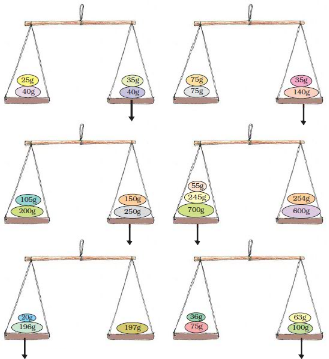
- Yes, the weight of the left pan of figure 4 in which the weights measure 55 g, 245 g and 700 g is 1 kg.
Sum of the weights = 55 + 245 + 700 g = 1000 g We know 1000 g = 1 kg
So, the weight of the left pan of figure 4 is 1 kilogram.
- We know
1 kg = 1000 g
Thus, there are 1000 grams in 1 kilogram.
Page No 138:
Question 1:
Grams and Kilograms Name 5 things that we usually buy —
| In grams | In kilograms |
| 1. | 1. |
| 2. | 2. |
| 3. | 3. |
| 4. | 4. |
| 5. | 5. |
Answer:
| In grams | In kilograms |
| 1. Pomegranate powder | 1. Vegetables |
| 2. Turmeric powder | 2. Fruits |
| 3. Colgate powder | 3. Sugar |
| 4. Soap bar | 4. Rice |
| 5. Chilli powder | 5. Wheat |
Disclaimer: The purpose of this section is to make the students observe their surroundings. The answer may vary from student to student based on his/her experience. It is highly recommended that the students prepare the answer on their own.
Page No 139:
Question 1:
Guess and write the weight of each thing he bought—in g or kg.
| Items | Weight |
| Rice | 5 |
| Sugar | 1 |
| Mustard seeds | 10 |
| Wheat | 3 |
| Dal | 500 |
| Tea | 250 |
| Pepper | 25 |
Answer:
| Items | Weight |
| Rice | 5 kg |
| Sugar | 1 kg |
| Mustard seeds | 10 g |
| Wheat | 3 kg |
| Dal | 500 g |
| Tea | 250 g |
| Pepper | 25 g |
Page No 144:
Question 1:
Now you show how Abdu will use these stone pieces to weigh —
(1).png)
(a) 4 kg of firewood
.png)
(b) 3 kg of firewood
.png)
(c) 7 kg of firewood
.png)
Answer:
(a)
.png)
Abdu will put the firewood in one of the pans of the balance and the 6 kg stone in the other. The pan with the stone will go down. Abdu will then put the 2 kg stone on the firewood and both the pans will become balanced. Thus, Abdu will use 2 kg and 6 kg stones to weigh 4 kg of firewood.
(b)
.png)
Abdu will put the firewood in one of the pans of the balance and the 5 kg stone in the other. The pan with the stone will go down. Abdu will then put the 2 kg stone on the firewood and both the pans will become balanced. Thus, Abdu will use 2 kg and 5 kg stones to weigh 3 kg of firewood.
(c)
(1).png)
Abdu will put the firewood in one of the pans of the balance and the 5 kg stone in the other. The pan with the firewood will go down. Abdu will then put the 2 kg stone in the pan with the 5 kg stone. Now, both the pans will become balanced. Thus, Abdu will use 2 kg and 5 kg stones to weigh 7 kg of firewood.
Page No 145:
Question 1:
Post Office Have you ever been to a post office? __________ What different things do people go there for? How much does a postcard cost? __________ How much does an inland letter cost? __________
Answer:
- Yes, I have been to post office several times.
- People go to a post office to send letters, telegrams and money orders. People also purchase envelopes, post cards, inland letters and stamps from there.
- The cost of a post card is Re 1.
- The cost of an inland letter is Rs 2.50.
Disclaimer: The purpose of this section is to make the students observe their surroundings. It is highly recommended that the students prepare the answer on their own. The answer provided here is for reference only.
Question 2:
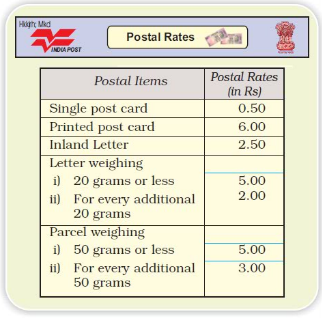
Look at the postal rates given in the chart.
1. How much will you have to pay for stamps on a letter weighing 50 grams? ___________
2. Akash wants to send a parcel of the Math Magic textbook to his friend Rani in Chennai. The book weighs 200 g. See the chart to find the cost of posting the book. __________ .png)
Answer:
1. Weight of a letter = 50 g Cost of a letter weighing 20 g or less = Rs 5 If the weight of a letter is more than 20 g, then the cost for every additional 20 g is Rs 2. Now, weight of letter = 50 g = 20 g + 20 g + 10 g Total cost paid for the stamps = Rs 5 + Rs 2 + Rs 2 = Rs 9
2. Cost of a parcel weighing 50 g or less = Rs 5 If the weight of a parcel is more than 50 g, then the cost for every additional 50 g is Rs 3. Weight of the parcel containing a book = 200 g = 50 g + 50 g + 50 g + 50 g Total cost to be paid by Akash = Rs 5 + Rs 3 + Rs 3 + Rs 3 = Rs 14
Thus, Akash has to pay Rs 14 for posting the book.
Page No 146:
Question 1:
Read the weight shown in the picture. Find out the cost of sending a parcel of that weight. 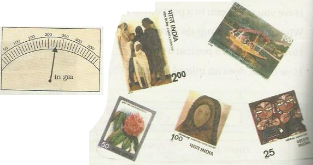
Parcel weight = _______ Cost of stamps = _______
Answer:
Weight of the parcel = 230 g Cost of a parcel weighing 50 g or less = Rs 5 If the weight of the parcel is more than 50 g, then the cost for every additional 50 g is Rs 3. Now, weight of the parcel = 230 g = 50 g + 50 g + 50 g + 50 g + 30 g ∴ Cost of the stamps = Rs 5 + Rs 3 + Rs 3 + Rs 3 + Rs 3 = Rs 17
So, the total cost of sending the parcel of 230 g is Rs 17. Parcel weight = 230 g Cost of stamps = Rs 17
Question 2:
How Many Stamps? • Rahul needs stamps of Rupees 25 for his parcel. He went to the post office. Only stamps of Re 1, Rs 2, Rs 5 and Rs 10 were there at that time. Using those stamps in how many different ways can he make Rs 25?
• Can you show five different ways? What is the heaviest parcel he can send using stamps of Rs 25?
Answer:
The 5 different ways are given below: (1) Rahul can buy five stamps of Rs 5 each in order to buy stamps of Rs 25 for his parcel. Cost of 1 stamp = Rs 5 Cost of 5 stamps = Rs 5 × 5 = Rs 25
(2) Rahul can buy two stamps of Rs 10 each and one stamp of Rs 5 in order to buy stamps of Rs 25 for his parcel. Cost of two stamps of Rs 10 each = Rs 10 × 2 = Rs 20 Total cost of two stamps of Rs 10 each and one stamp of Rs 5 = Rs 20 + Rs 5 = Rs 25
(3) Rahul can buy ten stamps of Rs 2 each and one stamp of Rs 5 in order to buy stamps of Rs 25 for his parcel.
Cost of ten stamps of Rs 2 each = Rs 2 × 10 = Rs 20 Total cost of ten stamps of Rs 2 each and one stamp of Rs 5 = Rs 20 + Rs 5 = Rs 25
(4) Rahul can buy three stamps of Rs 5 each and five stamps of Rs 2 each in order to buy stamps of Rs 25 for his parcel. Cost of three stamps of Rs 5 each = Rs 5 × 3 = Rs 15 Cost of five stamps of Rs 2 each = Rs 2 × 5 = Rs 10 Total cost of three stamps of Rs 5 each and five stamps of Rs 2 each = Rs 15 + Rs 10 = Rs 25
(5) Rahul can buy three stamps of Rs 5 each and one stamp of Rs 10 in order to buy stamps of Rs 25 for his parcel. Cost of three stamps of Rs 5 each = Rs 5 × 3 = Rs 15 Total cost of three stamps of Rs 5 each and one stamp of Rs 10 = Rs 15 + Rs 10 = Rs 25
Question 3:
Our Weight Together A frog was struggling to escape from the mouth of a crow. How can I escape? — the frog thought. Suddenly a trick came to his mind. He asked the crow — Are you good at arithmetic? If yes, then I will ask you a problem.
Your weight is 650 g and I am only 145 g. How much do we weigh together?
The crow was good at mathematics, so he sappily opened his beak to answer. What happened after that? So what was the answer the crow wanted to give? ___________

Answer:
Weight of the crow = 650 g Weight of the frog = 145 g Total weight of the crow and the frog = 650 g + 145 g = 795 g Working: 650+145795The crow calculated the total weight as 795 g and when he opened his mouth to answer, the frog escaped from his mouth.
Page No 147:
Question 1:
Now, you also fill the table by finding out the age, height and weight of any five friends.
| Name | Age | Height | Weight |
Answer:
| Name | Age | Height | Weight |
| Akshay | 10 years | 130 cm | 40 kg |
| Varun | 11 years | 135 cm | 42 kg |
| Ankita | 9 years | 120 cm | 38 kg |
| Shikhar | 9 years | 125 cm | 37 kg |
| Pooja | 11 years | 130 cm | 35 kg |
Disclaimer: The purpose of this section is to make the students observe their surroundings. It is highly recommended that the students prepare the answer on their own. The answer provided here is for reference only.
Page No 148:
Question 1:
How Many Oranges? All oranges have equal weight. The two papayas have the same weight. The weights in the first and second balances are equal. How many oranges balance the weight in the third?
.png)
Answer:
In the first balance, we see that the total of weight of 3 oranges is equal to the combined weights of an orange and a mango. As all the oranges are of the same weight, we can say that the weight of a mango is equal to the weight of 2 oranges. In the second balance, we see that the total weight of 2 papayas is equal to the combined weights of 2 oranges and a mango. But as two oranges and a mango weigh the same, we can say that the weight of 2 papayas is equal to the weight of 2 mangoes. Thus, the weight of each papaya is equal to the weight of each mango and the weight of a mango is equal to the weight of 2 oranges. Therefore in the third balance, we need 4 oranges on the right pan of the balance in order to have equal weights on both the sides.

Question 2:
Find That Marble There are 3 marbles of the same size but one marble is slightly heavier or lighter than the other two. Can you find which is that marble and if it is heavier or lighter? You can use a balance only two times.
Answer:
Suppose we have three marbles, A, B and C, such that one of them is slightly heavier or lighter than the other two. Let us first put marbles A and B in two different pans. We will get the following situations:
(1) If the two pans balance each other, then marble C is either heavier or lighter than the other two marbles. To check this, let us put marbles A and C in the two different pans. If the pan containing marble C goes down, then we can say that marble C is heavier than marbles A and B. If the pan containing marble A goes down, then we can say that marble C is lighter than marbles A and B.
(2) Suppose the two pans containing marbles A and B do not balance each other. Let the weight of marble A be less than that of marble B. Now, let us remove marble B from the pan and put marble C in its place. After this, let us compare the weights of marbles A and C. If the two pans balance each other, then we can say that marble B is heavier than marbles A and C. If the pan containing marble C goes down, then we can say that the weights of marbles B and C are equal and marble A is lighter than marbles B and C.